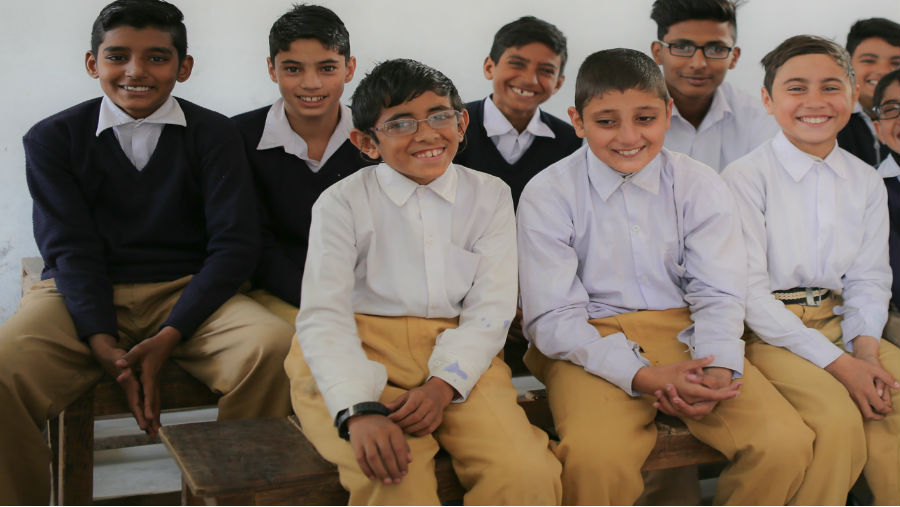Join a powerful, unprecedented alliance for better eye health for all.
Join IAPB-
Choose an alternate language here
 Children with visual impairment are lagging behind in both school enrollment and learning outcomes, according to new research from the World Bank and the EYElliance released on the International Day of Persons with Disabilities. School eye health programmes, which provide vision screening and eyeglasses to children in schools, are a simple solution.
Children with visual impairment are lagging behind in both school enrollment and learning outcomes, according to new research from the World Bank and the EYElliance released on the International Day of Persons with Disabilities. School eye health programmes, which provide vision screening and eyeglasses to children in schools, are a simple solution.
The study, Looking Ahead: Visual Impairment and School Eye Health Programs, finds that after controlling for other factors affecting educational outcomes, children with visual impairment are on average five to seven percentage points less likely to ever enroll in school, complete their primary education, and be literate than children without disabilities. This finding is based on analysis of census data for 21 countries (*).
Using data from student assessments, the study also finds that for 10 countries in Francophone Africa (*), again after controlling for other factors affecting learning outcomes, children with difficulties seeing clearly in the classroom perform less well than other children on reading and mathematics tests in primary schools. The negative effects associated with vision impairment are substantial and can be as large as the negative effects caused by socio-economic disadvantage.
“Ensuring that children with visual impairment have the same opportunities to go to school and learn as other children is essential to reduce learning poverty, which is the inability to read and understand a simple text at age 10,” said Quentin Wodon, World Bank lead economist and co-author of the study. “A simple and low-cost solution for most children with visual impairment is to provide eyeglasses through school eye health programmes.”
School eye health programmes have been successfully piloted in many countries. They consist of three major activities: (1) school-based vision screening, typically by teachers or nurses; (2) school-based eye exams and referrals for more serious conditions; and (3) eyeglasses delivery or advanced treatment as needed. While some children with visual impairment require customized glasses or advanced treatment, typically most children needing glasses can have their vision corrected with ready-made or ready-to-clip glasses within a matter of minutes. Randomized control trials suggest that correcting vision impairment improves student learning.
A survey of some of the largest non-profit organizations implementing school eye health programs in the world suggests that the cost of the programmes is typically low. Unfortunately, in Francophone Africa, only about 5 percent of students in grade 2 and a little over 7 percent of students in grade 6 participated in eye screening tests in 2014. These programmes should be scaled up nationally. Experiences suggest that this can be done, including in low-income counties.
“Eye health is a key link between health, education, and economic prosperity,” said Elizabeth Smith, Co-Founder and CEO of the EYElliance. “Ministries of Education and Health in low- and middle-income countries have an impact opportunity at hand. Liberia’s recent experience suggests that national, government-led school eye health initiatives are both achievable and affordable.”
Ensuring inclusive and equitable quality education for all and reducing learning poverty by half – a key target for the World Bank – require paying attention to children with disabilities, including those with visual impairment. Existing experiences provide a road map on how to make progress.
*The 21 countries included in the analysis of disability gaps for educational outcomes (ever enrolling in school, completing primary education, and literacy) are: Bangladesh, Benin, Burkina Faso, Cambodia, Costa Rica, Dominican Republic, Ethiopia, Ghana, Indonesia, Kenya, Liberia, Mali, Malawi, Mexico, Mozambique, Peru, Senegal, South Africa, South Sudan, Vietnam, and Zambia. The 10 countries included in the analysis of the impact of seeing difficulties on student performance in francophone Africa are: Benin, Burkina Faso, Burundi, Cameroun, Congo (Republic of), Cote d’Ivoire, Niger, Senegal, Chad, and Togo.
For more information, please visit:
Image on top: School children in Pakistan pose for a photo/ Mohammed Omer